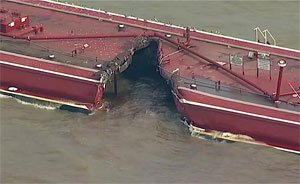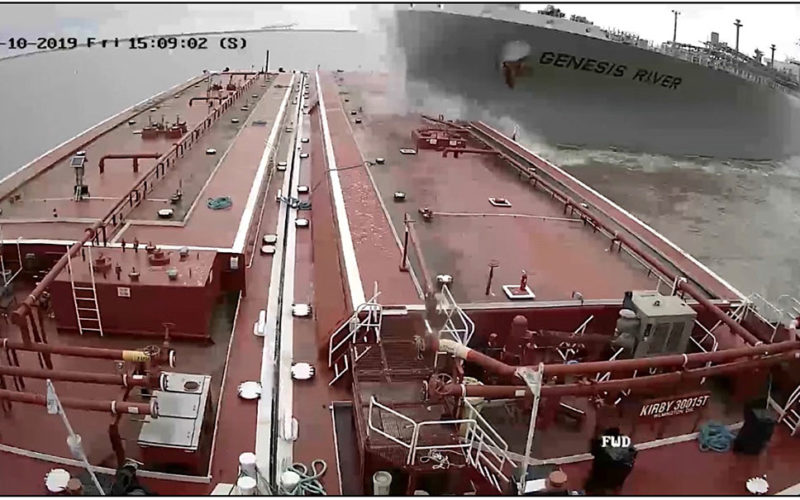
The speed of a tanker was a primary factor in a T-bone collision in the Houston Ship Channel that nearly tore a barge in half and caused a chemical spill, federal investigators determined.
The 754-by-122-foot Genesis River struck a barge pushed by the towboat Voyager at about 1515 on May 10, 2019 near the Bayport Ship Channel. Genesis River hit 30015T at 9 knots, tearing it open. More than 11,000 barrels of gasoline blending stock spilled into the waterway.
Damage to Genesis River, 30015T and another barge in the tow totaled about $3.2 million, while cleanup costs exceeded $12 million, the National Transportation Safety Board (NTSB) said in its accident report. Vessel movements within the channel were impacted for five days.
The incident happened after the outbound Genesis River passed the inbound liquefied gas carrier BW Oak near the Bayport Flare. The Houston pilot conning Genesis River lost control of the ship, which crossed the channel into the path of the 1,700-hp Voyager and its two barges, the NTSB said.
“The combined effect of the speed of Genesis River and the passing of another large vessel in the asymmetrically shaped channel at the southern terminus of the Bayport Flare resulted in an uncontrollable sheer to port by Genesis River, initiating a chain of events that led to the collision,” the report said.
In a prepared statement, the Houston Pilots said it is working with stakeholders to address key NTSB findings. However, the group said a Genesis River crewmember’s failure to activate an engine override soon after meeting BW Oak contributed to the outcome.
“The failure of the ship to provide the 17 available rpms requested by the pilot some three minutes before the collision played a part in the incident, and we are working on a recommendation to prevent that in the future,” the pilots said.
The mate did not activate the engine control button out of concern that doing so would damage the main engine — an outcome the NTSB suggested was unlikely. Yet the report also said additional engine rpms cannot be counted on when engines are operating at sea speed, as was the case.
The Panama-flagged Genesis River, operated by K-Line Energy Ship Management, got underway from a terminal just east of Houston at about noon after loading liquid propane. It departed with an even keel. Two Houston pilots were on the ship to split the voyage, a practice common on wide-body vessels.
The first pilot conned the ship during the transit through the upper channel. He combined large rudder angles with numerous engine commands, typically ranging from dead slow ahead to half ahead, to control the ship. Its speed during this period never exceeded 9.6 knots.
The pilot experienced moderate control issues after meeting two inbound ships. The first incident occurred at 1411 when Genesis River swung to port after passing the 580-foot tanker Stolt Inspiration, which was partially laden. The pilot increased the engine speed, increasing water over the propeller, to regain control — a move he called an “engine kick.”
The second incident occurred at 1440 just before the second pilot took the conn as Genesis River met the 600-foot tanker Marvel at 8 knots. As before, the first pilot increased the engine speed to stop the ship from swinging.
“Y’all over the place?” the second pilot asked his counterpart at 1444, just after taking the conn. “Yup,” the first pilot said, adding, “She’s takin’ lotsa wheel … typical Japanese ship, got a little bitty rudder on her.”
The second pilot requested full ahead on the ship’s engine at 1446. He also asked for the engine to be moved from maneuvering mode to full navigation mode. The setting is normally reserved for the open ocean and typically requires a 10-minute notice for speed changes.
Genesis River’s speed increased to 12 knots as it approached the 740-foot BW Oak, which was conned by another Houston pilot. The two ships met at the southern edge of the Bayport Flare, an area where the Bayport Ship Channel meets the Houston Ship Channel. Pilots on both ships considered the area safe to meet.
Genesis River’s heading began swinging to port before passing BW Oak at 1512. The second pilot issued a series of rudder commands to “check” the ship’s movement. At 1513 he requested additional engine rpms from the mate, who did not override the engine. Sensing trouble, the second pilot warned the relief captain helming the approaching Voyager, roughly seven-tenths of a mile away, that he was struggling to control the tanker.
“She’s not checkin’ up, Voyager,” the second pilot said moments later, according to the NTSB report. “What do you need me to do, captain?” responded the relief captain. “Go to the greens,” the second pilot said, meaning the Voyager tow should cross to the western side of the channel marked by green navigation beacons.
Voyager’s captain told investigators he had no good options once Genesis River started bearing down on his tow. A submerged obstacle was off to starboard, and stopping the tow would risk becoming stuck in the tanker’s path. “With Genesis River’s bow pointed directly at him, he felt that his only course of action was to cross the channel to the western side,” the report said.
The tow slowed to less than 4 knots while turning across the channel. The second pilot aboard Genesis River repeatedly urged the tow along, requesting that the vessels cut straight across the waterway. “Go, Voyager, go! Go, go, go!” the second pilot said, according to the NTSB report. Voyager’s relief captain responded, “I’m hooked up, hard over there, brother.”
Genesis River began swinging to starboard as the tow cut across the channel. The ship’s second mate repeatedly urged the second pilot to turn to port, but he did not acknowledge the requests. The ship briefly touched bottom in the eastern barge lane as it turned back to starboard.
The second pilot recognized a collision was likely and warned Voyager’s relief pilot to sound the alarm early on — an action that investigators said reduced the risk of injury aboard the towboat. Genesis River’s master, who had been called to the bridge, ordered the engine to emergency full astern moments before the collision.
The impact between the fully loaded ship and the 297-foot tank barge was violent. The ship’s unique hull form, without a bulbous bow, tore a 23-by-30-foot triangular gash through 30015T, breaching its No. 2 port and starboard cargo tanks. Voyager heeled significantly starboard and a broken starboard face wire snagged in the starboard prop. Barge MMI3041, outboard from the ship, rolled over upon impact but did not breach.
Reformate, a gasoline blending stock, spilled into the waterway. Local residents complained of a petrochemical smell and testing confirmed the presence of benzene or similar organic compounds in the air. Between 100 and 1,000 fish, shrimp and crabs died along a nearby stretch of shoreline.
NTSB investigators zeroed in on the meeting between Genesis River and BW Oak. They determined suction and bank effect yawed Genesis River to port, “overwhelming the full starboard rudder applied to counter this port yaw. The ship continued port across the channel, where the encounter with the east bank curved the ship’s path starboard and into Voyager’s barge,” the report said.
The pilot’s decision to set the engine to full navigation mode limited his ability to regain control of the ship. The “engine kicks” used by the first pilot when the ship began to swing were unavailable to the second pilot at this setting.
The ship’s higher speed also subjected it to greater hydrodynamic forces than would have been the case at slower maneuvering speeds, the NTSB determined.
Kirby Inland Marine praised the “heroic” actions of Voyager’s crew, who the company said were “exonerated” by the NTSB’s findings.
“Faced with a large ship careening toward them, out of control, they took the action they could to avoid a collision or minimize its impact,” Kirby spokesman Matt Woodruff said. “We are grateful for the professionalism displayed by our mariners under the most trying of circumstances.”
Key NTSB findings
•Maintaining stern trim while underway would have improved the handling characteristics of Genesis River.
•Wide-beam, deep-draft vessels meeting in the Houston Ship Channel in the vicinity of the northern and southern terminuses of the Bayport Flare have a higher risk of loss of control due to complex and varying hydrodynamic forces.
•Once Voyager and its tow began the turn to port, the collision was unavoidable.
•An increase in engine rpm to arrest Genesis River’s initial sheer, even if promptly executed after it was ordered by the pilot, would not have prevented the collision.
•The Genesis River pilot’s decision not to use emergency full astern or the anchors to avoid the collision was reasonable.
•The actions of the Voyager relief captain to attempt to avoid the collision by crossing the channel were reasonable, given the information available to him at the time he had to make the decision to maneuver.
•The Genesis River pilot’s early and frequent communications with Voyager mitigated the impacts of the accident and likely prevented loss of the towing vessel and injuries to its crew.

